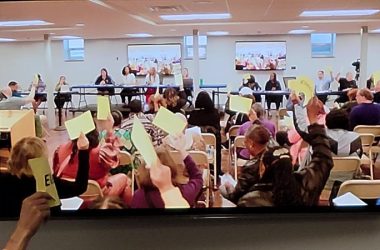
Two schools resorted to remote learning in December as the area, and the world, experienced the second-worst spike in COVID-19 cases since the pandemic began in early 2020.
District 161 officials announced on Dec. 15 that in-person classes and extracurricular activities at Parker Junior High in Flossmoor were canceled through the end of the quarter on Dec. 22.
Two days earlier, District 153 announced that three classes at Churchill School in Homewood would return to remote learning after 11 students at the school tested positive and 70 were quarantined because of possible exposure to the virus.
Both school districts are testing students weekly for COVID-19 using the SHIELD testing method developed by the University of Illinois. The saliva-based test can detect COVID-19 and its variants in symptomatic, pre-symptomatic and asymptomatic people.
The new Omicron variant of the virus has dominated pandemic news in the month since it was detected, but it does not appear to be the cause of the current surge.
Illinois Department of Public Health (IDPH) officials said the first Omicron case in the state was detected on Dec. 7. The Cook County Department of Public Health (CCDPH) said the first case in the Chicago suburbs appeared on Dec. 14.
The Delta variant remained the dominant strain of the virus, accounting for 95.8% of of cases in suburban Cook County the first two weeks of December. Delta, in fact, accounts for more than 64% of cases since the pandemic began, according to CCDPH.
The Homewood-Flossmoor area is experiencing the same surge in COVID-19 cases as the rest of the country and the world. After a deep dive in cases during the summer, H-F communities saw a surge that peaked on Sept. 11, receded, then surged again starting in late October.
The current case rate is higher than at any point since the worst surge in the pandemic in winter 2020.
Nevertheless, Omicron has grabbed headlines for good reason. Although it is still new and scientists are still studying its characteristics, what they have reported so far indicates Omicron has the potential to cause big problems.
The bad news is that Omicron appears to be much more transmissible than Delta, which was twice as transmissible as the original virus. It also appears that current vaccines are much less effective at preventing cases of Omicron.
As reported by National Public Radio, a study conducted by a South African health insurer, Discovery Health, and the South African Medical Research Council, indicates the Pfizer vaccine is only 30% effective at preventing Omicron infections. It is 80% effective at preventing infection by the Delta variant.
The good news from the study is that Omicron appears to cause milder versions of COVID-19, with fewer hospitalizations and deaths than typically caused by Delta. Even though breakthrough cases are more common with Omicron, vaccines appear to be effective at reducing the severity of disease.
According to IDPH, the Chicago resident who contracted Omicron had a mild case and did not require hospitalization.
“While we don’t have all the answers right now, we know the general prevention strategies we’ve been recommending – vaccination, boosters, masking, testing, physical distancing – are our best protection against the virus and its variants,” said IDPH Director Dr. Ngozi Ezike. “As long as the virus continues to circulate, it has the potential to mutate into new variants. Vaccination can help stop circulation, but we need more people to get vaccinated.”
As of Friday, Dec. 17, 62.7% of Homewood’s population and 66.1% of Flossmoor’s was fully vaccinated. Data is not yet available on the CCDPH website about booster rates.
The state and county initiated a vaccine push in December, with a flurry of mass vaccination and booster clinics. Visit dph.illinois.gov/covid19/vaccinationclinics.html to find times and locations.
The Centers for Disease Control and Prevention website, vaccines.gov, also remains a good starting point for finding vaccination locations.


